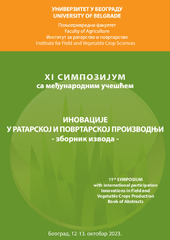| dc.description.abstract | Spices plants are characterized by a rich and specific chemical composition and are widely used for
many purposes (as spices in cooking, in folk medicine, in aromatherapy, in the perfume industry). In
this work, Raman spectra recorded directly from individual anise (Pimpinella anisum L.), caraway
(Carum carvi L.), coriander (Coriandrum sativum L.), and fennel (Foeniculum vulgare L.) fruits
revealed some characteristic bands that can be assigned mainly to primary plant metabolites. The most
characteristic signals at 1688 and 1568 cm−1 are due to lignin, which is a major component of cell
walls in the hard pericarp. This band is related to the stretching of the aromatic rings of the phenolic
compounds that form the polymeric structure of lignin. The intense band near 1442 cm−1 can be assigned
as the CH2 shear deformation vibration of unsaturated FA. The degree of unsaturation of FA can be
estimated from the peak area of the bands at 1240 and 1312 cm−1, which are due to in-phase ═CH−
symmetric rocking and a methylene twisting vibration, respectively. In general, monocyclic monoterpenes
show intense Raman bands due to stretching vibrations of C═C bonds at about 1680 cm−1. In the case
of limonene, signal evident at 1680 cm−1 due to ν(cyclohexene C═C), while for carvone these bands
occur at 1670 and 1644 cm−1. Most monocyclic terpenes also show a strong ring deformation vibration
between 730 and 760 cm−1, and for limonene this band is at about 780 cm−1. The score plot of PCA
indicates two groups of objects along the PC1 axis: fennel, caraway and anise, coriander. The variables
responsible for the differentiation at 1579, 1461, 1104 and 667 cm-1 could indicate lignin, UFA and
monoterpenes, respectively. Raman spectroscopy showed as fast and useful tool for fast recognition
of fruits essential oil content in spices plants. | sr |


